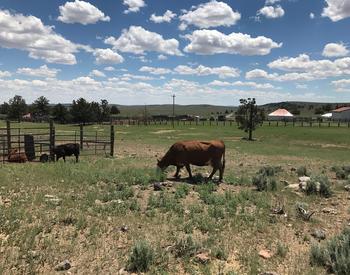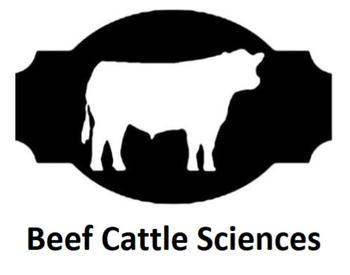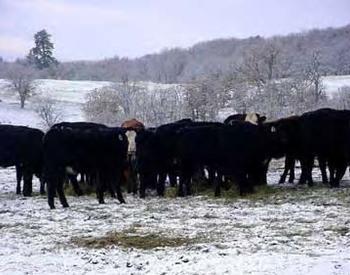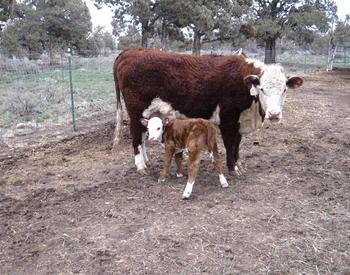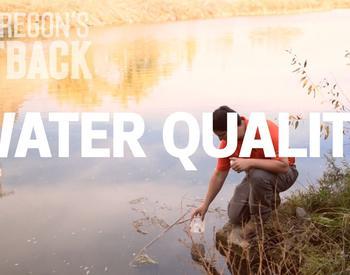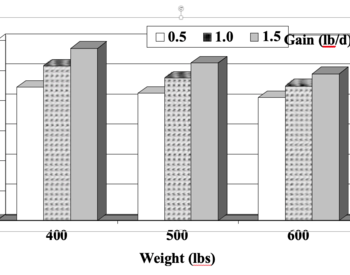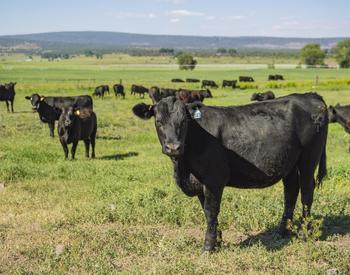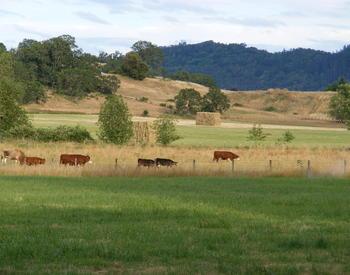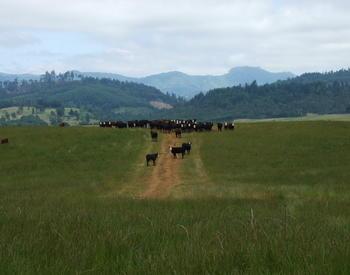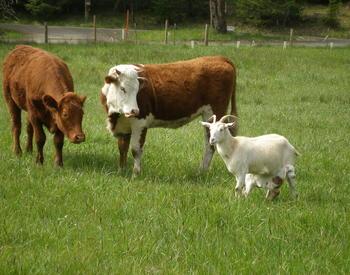Introduction
Annual feed costs for Oregon's beef producers are routinely greater than most, if not all, other regions of the U.S. Also, beef producers east of the Cascades (where 75% of Oregon beef cows are located) are challenged by a forage base that yields approximately three months of high-quality forage and nine months of poor-quality forage (Figure 1).
In addition, because of the average annual precipitation in this region is routinely less than 15 inches (60% of which comes in the form of snow) and there is extreme year-to-year variation in the amount and timing of precipitation, there can be tremendous variability in annual forage production.
Consequently, beef producers often must feed some form of harvested forage and/or supplement for four to seven months of the year. As a result, producers should routinely evaluate alternative feedstuffs as a means to supplement existing forage resources and reduce feed costs.
Considerations with alternative feedstuffs
When evaluating an alternative feedstuff for use in a nutritional management plan there are a number of considerations that should be evaluated prior to purchase. These include:
What is the nutrient content and availability?
When evaluating a feedstuff for nutrient content the best method is to have a representative sample sent to the lab certified by the National Forage Testing Association for nutrient analysis. This allows for accurate determination of nutrient content and proper balancing of diets to meet the animal's nutrient requirements.
The specific analyses needed to evaluate a feedstuff depends on the type of feedstuff and potential management concerns. A good overview of what to analyze in particular feedstuffs is provided in the Western Beef Resource Committee Cattle Producer’s Library.
If analysis from an accredited lab is not available and you are considering using an alternative feedstuff, contact your local Extension agent or beef cattle specialist, a nutritional consultant, or feed industry representative to get their professional opinion or “guess” as to the potential range in nutrient quality of a specific feedstuff.
Table 1 provides an approximate nutrient concentration of some alternative feedstuffs common in the Pacific Northwest. However, there is no substitute for a lab analysis and this should always be the first, and best, option when attempting to determine the nutrient value and cost of a potential feedstuff. Another important consideration when purchasing an alternative feedstuff is to price it based on the amount of nutrient supplied, corrected for the dry matter.
| Feedstuff | Type | Dry Matter (%) | CP (%) | TDN (%) | Comment/Concern |
|---|---|---|---|---|---|
| Mint Slug Silage | Low energy | 28 | 14 | 50 | unavailable CP |
| Grape Pomace | Low energy | 90 | 13 | 33 | low energy |
| Bluegrass Straw | Low energy | 90 | 5 to 9 | 54 to 60 | |
| Fescue Straw | Low energy | 90 | 5 to 9 | 47 to 55 | alkaloids; endophyte |
| Perennial Ryegrass Straw | Low energy | 90 | 4 to 9 | 49 to 63 | alkaloids; endophyte |
| Annual Ryegrass Straw | Low energy | 90 | 3 to 5 | 49 to 53 | low CP; low dig. and intake |
| Cereal Grain Straw | Low energy | 90 | 2 to 5 | 44 to 50 | low CP; low dig. and intake |
| Corn Stalks | Low energy | 80 | 5 | 54 | low CP; nitrate |
| Turnip Tops | High energy | 13 | 22 | 67 | nitrate; mold |
| Turnips, Roots | High energy | 9 | 12 | 85 | choke; polio; fog fever; gluosinolates; nitrates |
| Corn Cannery Waste | High energy | 21 | 7 | 70 | |
| Distillers Grains, Wet | High energy | 30 | 34 | 95 | sulfur; polio; copper status |
| Distillers Grains, Dry | High energy | 92 | 30 | 90 | sulfur; polio; copper status |
| Brewers Grains, Wet | High energy | 24 | 26 | 67 | |
| Cull Potatoes | High energy | 20 | 10 | 85 | choke; glucoalkolaids; pesticides; limit to <50% of diet |
| Potato Waste | High energy | 20 | 10 | 85 | |
| Lentil/Pea Screening | High energy | 88 | 17 | 68 | dirt contamination |
| Grass Seed Screenings | High energy | 88 | 12 | 58 to 65 | ergot; alkaloids |
| Grain Screenings | High energy | 90 | 14 | 70 | dust |
| Bakery Waste | High energy | 92 | 10 | 88 | high fat |
| Cull Onions | High energy | 10 | 12 | 60 | choke; anemia; limit to <25% of diet |
| Cull Carrots | High energy | 12 | 10 | 84 | fat color (of used in finishing) |
| Beet Pulp, Dry | High energy | 91 | 9 | 75 | lower intake; limit to <50% of diet |
| Cull Beans, Dry | High energy | 90 | 24 | 85 | laxative; limit to <30% of diet |
| Camelina Meal | Protein | 92 | 37 | 89 | palatability; glucosinolates; limit to <10% of diet |
| Canola Meal | Protein | 90 | 44 | 69 | palatability |
| Sunflower Meal | Protein | 90 | 39 | 64 | bulky; high in degradable protein |
| Soybean Meal | Protein | 90 | 50 | 85 | high CP; very palatable |
| Cottonseed Meal | Protein | 91 | 46 | 76 | gossypol |
| Annual Kochia | Weed | 87 | 17 | 57 | nitrate; photosensitization; alkaloids; oxalate |
| Perennial Pepperweed, vegetative | Weed | 20 to 40 | 16 to 20 | NA | high CP |
| Russian Knapweed, Hay | Weed | 90 | 13 to 18 | 50 to 70 | good CP; toxic to horses |
Are there hauling, storage and/or feeding issues?
Obtaining an alternative feedstuff may seem to be a great deal based on price and availability.
However, storage and feeding considerations can make using such a feedstuff difficult, if not impossible, unless proper facilities are available. Common storage and/or feeding concern with alternative feeds include the following five issues.
Moisture content
Some alternative feedstuffs, such as wet distillers grains, cull onions and cull potatoes can consist of up to 90% water.
This can make hauling difficult and expensive. For example, a ton of cull onions that are 10% dry matter will contain 1,800 pounds of water! This can make a seemingly "great deal" cost prohibitive if the onions have to be hauled any substantial distance.
Another challenge with high moisture feedstuffs is storage. They can tend to "run" or flow once unloaded and they have a tendency to ferment, especially in warm environments, which causes mold/spoilage issues. In addition, high moisture feedstuffs can freeze during cold weather making handling and consumption by cattle difficult.
Feedstuff consistency/texture
The bulkiness and associated storage space required for a given volume of a feedstuff varies. Sacking feeds is useful for feeding and storage in many cases but typically can be expensive. Some foodstuff can be stored in upright bins, whereas other feedstuffs require storage areas such as a commodity shed bays. However, feed storage facilities do not need to be fancy or expensive. They just need to be functional and well-maintained.
Feed delivery
On-farm feed mixing and delivery system should be considered when selecting potential alternative feedstuffs. Particle size and other mixing characteristics can affect the flexibility of including a specific feedstuff as part of a feeding program.
Feeder design
Feeder construction affects what type of feeds can be effectively provided to livestock. Some feedstuffs can be fed on the ground whole. Others, such as wet distillers grain, will require a bunk.
Purchasing agreement
A purchasing agreement is something that most producers do not consider. However, if nutritional management decisions are made based on an anticipated availability, quality and quantity of a feedstuff, a contract describing the expectations of both parties is just good business.
Are toxins or contaminants a concern?
Many feedstuffs contain toxins or contaminants that can affect the health of cattle if present in high concentrations.
If not managed properly, feeding these feedstuffs can result in decreased production and, potentially, death. Knowledge of the feedstuff, and more importantly, experience feeding it to cattle is the first step in determining if there are potential concerns with toxins or contaminants.
In addition, your Extension agent, Extension beef specialist or nutritional consultant can be a valuable resource when evaluating alternative feedstuffs for a nutritional management plan. Some of the more common toxins/contaminants that are present in some feedstuffs available in the Pacific Northwest include the following six items.
Nitrate
Nitrate intake from 15 to 45 grams per 100 pounds of body weight is considered toxic and can result in rapid death. For more specific information on nitrate toxicity and management recommendations please see “Nitrates in Cattle Feed and Water” in the Western Beef Resource Committee Cattle Producer’s Library (CL355).
Alkaloids
There are numerous types of alkaloids present in certain feedstuffs. For example, tall fescue can have ergovaline, perennial ryegrass can have ergovaline and Lolitrem B, and cull potatoes can have glucoalkaloids.
A consequence of feeding high-alkaloid feedstuffs can range from temporary neurological problems, decreased performance and reproductive success, and in severe cases, death.
More information on alkaloids can be found in "Toxic Contaminants in Harvested Forages" and "Health Concerns with Feeding Grass-Seed Straw Residues" in the Western Beef Resources Committee Cattle Producer's Library (CL619 &CL626).
Ergot
Ergot is a disease caused by the fungus Claviceps purpurea and occurs primarily in cereal crops and grasses. The most common sign of ergot is a dark purple to black sclerotia (ergot bodies) found replacing the grain in the heads of cereals and grasses just prior to harvest.
Wet weather and/or wet soils favor germination of ergot bodies. Ergot can be toxic when the sclerotia are consumed by animals. All domestic animals are susceptible, including birds, but cattle seem to be the most susceptible.
More information on ergot can be found in an online publication from North Dakota State University (McMullen and Stoltenow, 2002).
High sulfur content
Sulfur is an essential mineral for cattle; however, when dietary concentrations (from water AND feed) are greater than 0.3 to 0.4% it can result in health issues. The two primary concerns are decreased copper availability and development of polioencephalomalacia (commonly called “brainers”). An Extension publication by Ward and Lardy (2005) provides an overview of sulfur nutrition of beef cattle.
Glucosinolates
Glucosinolates are secondary metabolites found in all brassicas (examples include turnips, cabbage, flaxseed, canola, rapeseed, camelina, cauliflower and broccoli). Mature ruminants are more tolerant of glucosinolates than young ruminants. Consequences of excessive glucosinolate intake include weight loss, iodine deficiency (goiter), reduced intake and depressed milk production.
Mold
Mold growth on feedstuffs is caused by the growth of microscopic fungal organisms — most always in the presence of excessive moisture. This reduces nutrient content and palatability and can, in severe cases, result in illness and/or death. Also, pregnant cows consuming moldy forage can be expected to have a 3% to 10% incidence of abortion (referred to as mycotic abortion; Western Beef Resource Committee Cattle Producer’s Library, CL619).
Is there university feeding research available?
An excellent source of information on alternative feedstuffs is university research. The internet is a wonderful tool that allows producers to search for information on a particular feedstuff; however, it should come as no surprise that not everything on the internet is factual, so use caution in interpreting information obtained in this manner.
Nevertheless, our nation's land grant universities have online resources that can be an excellent source of science-based information on specific feedstuffs. A good place to start is OSU's Beef Cattle Sciences blog site.
Conclusions
Alternative feeds can provide beef producers with economical alternatives to traditional feedstuffs. However, special considerations must be made related to moisture content, nutrient content, toxicity potential and facilities necessary to properly handle and feed the feedstuff.
Another point to remember when feeding a new feedstuff to livestock is to start at a low/moderate level of diet inclusion and slowly work them up to a level deemed safe by a nutritionist or by past personal experience. Also, remember that your local county Extension agent and state beef specialist(s) can be a great asset in helping answer questions related to alternative feedstuffs.
References
Bohnert et al. 2014. Knapweed Hay as a Nutritional Supplement for Beef Cows Fed Low-Quality Forage. Rangeland Eco. and Mgmt. 67(2):219-233.
Cooke, R. F., and D. W. Bohnert. 2011. Balancing Diets for Beef Cattle. OSU Beef Cattle Sciences. BEEF059.
Ganskopp, D., and D. Bohnert. 2001. Nutritional Dynamics of 7 Northern Great Basin Grasses. J. Range Manage. 54:640-647.
Lardy, G., and V. Anderson. 2009. North Dakota State University Extension Service. AS-1182.
McMullen, M., and C. Stoltenow. 2002. Ergot. North Dakota State University Extension Service. PP- 551.
Tripathi, M. K., and A. S. Mishra. 2007. Glucosinolates in animal nutrition: A review. Anim. Feed Sci. Technol. 132:1-27.
Vavra, M., and R. J. Raleigh. 1976. Coordinating Beef Cattle Management with the Range Forage Resource. J. Range Manage. 29:449-452.
Ward, M., and G. Lardy. 2005. Mineral Nutrition. North Dakota State University Extension Service. AS-1287.
This document is part of the Oregon State University Beef Cattle Library. Prior to acceptance, this document was anonymously reviewed by two experts in the area.
